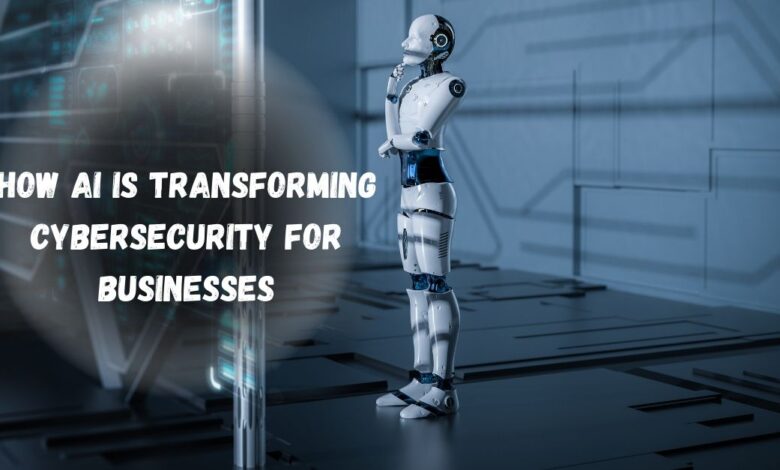How AI is Transforming Cybersecurity for Businesses in 2024

the Cybersecurity for Businesses landscape has reached new levels of complexity, with the volume and sophistication of cyber threats escalating at an unprecedented pace. Businesses now face not only traditional risks like malware and phishing but also advanced persistent threats (APTs) and increasingly clever ransomware. Traditional security methods are struggling to keep up, prompting companies to look for more innovative solutions. Artificial intelligence (AI) has emerged as a powerful tool in cybersecurity, equipping businesses with the ability to predict, detect, and respond to cyber threats more efficiently than ever before.
AI-driven cybersecurity solutions are reshaping how businesses protect sensitive data, manage network security, and mitigate risks. By leveraging AI, companies can build stronger defenses against both external and internal threats. This article will explore the impact of AI in several critical areas of cybersecurity, including real-time threat detection, generative AI for advanced defense tactics, ransomware mitigation, behavioral analytics, and strategies to address the cybersecurity skills gap. Together, these advancements are setting a new standard for security in an increasingly digital world.
AI in Threat Detection and Response
The Growing Need for Real-Time Threat Detection
In today’s fast-paced cyber landscape, cyberattacks are becoming more frequent and sophisticated. Businesses are now handling a vast amount of sensitive data, often stored across cloud environments and accessed remotely, making them more vulnerable to attacks. Traditional detection systems struggle to keep up, as they lack the agility to respond quickly to dynamic threats. This has increased the demand for real-time threat detection capabilities, where businesses can identify and mitigate threats before significant damage is done.
How AI Enhances Detection and Response
AI-driven systems are transforming threat detection by analyzing large volumes of data instantaneously, identifying anomalies, and recognizing patterns associated with malicious activities. Machine learning algorithms continuously learn from new data, becoming better over time at detecting unusual behaviors indicative of potential threats. This proactive approach allows businesses to respond to threats more swiftly and accurately, reducing response times significantly.
Specific Applications
AI algorithms have proven especially effective in identifying phishing attempts, detecting malware, and recognizing the signatures of advanced persistent threats (APTs). Using AI, security systems can differentiate between routine network activities and suspicious behaviors, even if they are subtle. This capability helps prevent breaches before they fully manifest, offering a layer of proactive defense that traditional methods cannot achieve.
Examples of Cybersecurity for Businesses Tools
Popular tools like CrowdStrike and Darktrace have set the standard for AI-driven threat detection and response. These platforms use AI to analyze real-time network data, providing businesses with insights into potential vulnerabilities and allowing for automated responses to suspicious activities. By continuously monitoring traffic patterns, these tools can prevent many cyberattacks, safeguarding businesses from data breaches and financial losses.
Case Studies
Businesses that have implemented AI-driven tools have reported substantial improvements in cybersecurity outcomes. For instance, a major financial institution that adopted Darktrace’s AI-based monitoring system successfully detected and neutralized a phishing attempt within minutes, preventing what could have been a costly data breach. This case highlights the value of reduced detection-to-response times, showcasing how AI-driven cybersecurity can mitigate risks in real-world scenarios.
Generative AI in Cybersecurity
Emergence of Generative AI
Generative AI is a form of artificial intelligence that can create new data based on learned patterns, which has both offensive and defensive implications for cybersecurity. For businesses, this technology is being used to simulate attacks, assess vulnerabilities, and predict how cybercriminals might exploit system weaknesses. By using generative AI, security teams gain insights into potential attack vectors, allowing them to strengthen defenses proactively.
Offensive Uses and Defense Strategies
One of the key applications of generative AI in cybersecurity is its ability to model sophisticated attack scenarios. Cybersecurity teams can use these simulations to anticipate hacker tactics, creating tailored defense strategies for potential threats. This helps organizations prepare for a variety of attacks, from phishing schemes to complex network intrusions, allowing them to preemptively strengthen their systems.
Benefits of Proactive Defense
Generative AI enables businesses to develop robust defense mechanisms by anticipating possible security weaknesses. Through AI-driven simulations, businesses can test their systems against various types of attacks, fortifying them against known and unknown threats. This proactive approach reduces the risk of breaches, saving businesses both time and resources.
Risks of Generative AI Misuse
While generative AI offers many advantages for cybersecurity, it also poses potential risks. Cybercriminals are beginning to leverage generative AI for malicious purposes, such as crafting highly convincing phishing emails or bypassing security protocols with automated attacks. To counteract these threats, businesses must employ AI solutions that can recognize and mitigate attacks originating from generative AI, staying ahead in the cybersecurity arms race.
In these initial sections, we’ve outlined the evolving role of AI in cybersecurity, particularly through real-time threat detection and generative AI for simulating potential attacks. Together, these approaches enable businesses to enhance their defensive capabilities, build a proactive security posture, and better anticipate the tactics of cyber adversaries. This framework equips organizations to not only react to cyber threats but actively prepare for them in a way that strengthens overall cybersecurity.
The remaining sections will delve into ransomware defense, behavioral analytics, and how AI is addressing the cybersecurity skills gap to further illustrate AI’s transformative power in securing today’s business environments.
Ransomware Defense and Mitigation (250-300 words)
Rising Ransomware Threats
Ransomware attacks have surged in recent years, targeting businesses of all sizes with increasing frequency and severity. In 2024, these attacks are more sophisticated, often leveraging advanced techniques to bypass traditional defenses. As a result, businesses are forced to find more robust strategies to combat ransomware, especially as attacks grow more targeted and economically devastating.
AI’s Role in Ransomware Detection and Response
AI has become essential in ransomware defense, allowing systems to detect patterns associated with ransomware activities long before they lead to data encryption. Machine learning algorithms analyze vast amounts of network data, identifying signs of malicious activity such as unauthorized file access or abnormal data movements. This early detection enables businesses to isolate ransomware before it spreads, stopping the attack in its tracks.
Automated Response and Recovery
Beyond detection, AI-driven cybersecurity solutions support automated responses that contain ransomware threats. By isolating infected systems, these tools prevent ransomware from spreading to other parts of the network. Additionally, AI aids in initiating data recovery processes, helping businesses restore encrypted data quickly, thus minimizing downtime and financial losses.
Success Stories
Several organizations have successfully implemented AI to mitigate ransomware threats. For instance, healthcare institutions, often targeted by ransomware, have used AI to detect and stop attacks before patient data was compromised. These cases underscore AI’s ability to maintain business continuity by reducing the impact of ransomware attacks, thereby ensuring that businesses can operate without major disruptions.
Behavioral Analytics for Cybersecurity
What is Behavioral Analytics?
Behavioral analytics in cybersecurity involves studying users’ typical actions and patterns within a network. This approach enables security teams to detect unusual behaviors that could indicate insider threats or external compromises. Behavioral analytics is particularly useful for businesses where insider threats pose significant risks, as traditional security methods often miss these types of anomalies.
AI-Driven Behavioral Analysis
AI-powered behavioral analytics takes this approach further by continuously learning from user behaviors to detect even subtle deviations. Machine learning algorithms track patterns such as login times, data access frequency, and specific actions within network applications. When AI systems detect unusual activities—such as access to sensitive data at odd hours or abnormal download patterns—they flag these as potential threats.
Insider Threat Detection
AI-based behavioral analytics is invaluable for identifying insider threats, which are often challenging to detect due to their subtle nature. For example, an employee attempting to access unauthorized files or transfer data outside the organization could trigger AI-based alerts. These systems allow security teams to address insider threats before they lead to data breaches or other forms of loss.
Benefits for Businesses
By incorporating behavioral analytics, businesses can significantly reduce the likelihood of breaches, enhance compliance with regulatory standards, and strengthen their overall security posture. With AI handling much of the analysis, businesses gain insights faster, improving their ability to respond to and neutralize threats promptly.
Tools and Examples
Leading tools in behavioral analytics, like IBM QRadar and Microsoft Sentinel, use AI to monitor user behaviors and alert teams to potential issues. Companies leveraging these tools report higher levels of security and early detection of insider risks, safeguarding their data and reputations.
Addressing the Cybersecurity Skills Gap with AI
The Growing Cybersecurity Talent Shortage
The demand for skilled cybersecurity professionals far outpaces the supply, creating a critical skills gap that leaves businesses vulnerable. This shortage has forced organizations to look for alternatives, as manual cybersecurity efforts alone cannot meet today’s demands.
How AI Helps Close the Gap
AI provides significant support by automating routine security tasks, enabling existing cybersecurity teams to focus on complex issues rather than repetitive tasks. Automated processes, such as threat detection and data analysis, allow businesses to maintain robust defenses even with limited personnel.
Upskilling with AI
AI also helps current staff enhance their skills by offering insights and facilitating advanced threat detection, effectively acting as a “force multiplier.” AI-driven tools enable less experienced employees to tackle sophisticated security challenges, accelerating their learning and providing hands-on experience in managing cyber threats.
Long-Term Benefits for Businesses
By integrating AI into their cybersecurity frameworks, businesses can fill the skills gap without relying entirely on additional personnel. This approach not only strengthens security but also fosters resilience, ensuring that businesses remain protected against evolving threats while minimizing dependency on scarce human resources.
In 2024, AI is reshaping cybersecurity for businesses by improving threat detection, enhancing ransomware defenses, leveraging behavioral analytics, and bridging the cybersecurity skills gap. These AI-driven advancements equip businesses with proactive defense capabilities that go beyond traditional security methods. With AI systems analyzing massive amounts of data, businesses can detect, respond to, and even predict cyber threats more effectively, safeguarding valuable data and maintaining operational continuity.
Looking ahead, the role of AI in cybersecurity is only expected to grow, enabling more businesses to adopt resilient and adaptive security solutions. As cyber threats continue to evolve, organizations that embrace AI-driven cybersecurity tools will be better prepared to face future challenges. To secure their digital landscapes and remain competitive, businesses should consider integrating AI solutions as an essential part of their cybersecurity strategy.
read also: Enhancing Macbook Security: Best Practices
Resources:
CrowdStrike – AI-driven cybersecurity solutions for real-time threat detection and response.
Darktrace – AI technology that autonomously detects and responds to cyber threats.
IBM QRadar – A tool for threat detection and security intelligence through behavioral analytics.
Microsoft Sentinel – Cloud-native security information and event management (SIEM) for behavioral analytics.
ISACA’s Cybersecurity Trends – Insights on emerging trends and the future of cybersecurity.
Hyperproof AI Cybersecurity Insights – Analysis of how AI is influencing cybersecurity practices and strategies.



